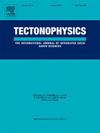Lithospheric temperature response to asthenosphere updoming and the upper mantle-crustal magmatic underplating in the Western Ohře (Eger) Rift area, Czechia
IF 2.6
3区 地球科学
Q2 GEOCHEMISTRY & GEOPHYSICS
引用次数: 0
Abstract
The Western Ohře (Eger) Rift is characterized by frequent earthquake swarms, elevated CO₂ emissions, and Pleistocene volcanism. Understanding the lithospheric temperature is an essential for integrating these phenomena within a broader geodynamic context. In order to contribute to these research goals, we modelled thermal evolution of the region using an axisymmetric geothermal model and numerically solved the transient heat conduction equation. The simulation begins at 35 Ma, when the asthenosphere uplifted from 100 km to 75 km depth within a 90-km diameter-wide region. This updoming was followed by two episodes of basaltic underplating at depths of 30–33 km during 15–10 Ma and 5–1 Ma. We modelled the underplating as a sequence of ∼100 m thick intrusions, 30 km in diameter, emplaced at 1 Myr intervals. Each intrusion released latent heat of crystallization between the liquidus (1,387 °C) and solidus (720 °C) temperatures. The modelled lithospheric temperatures indicate that the 300 °C isotherm, often marking the brittle-ductile transition, is located at ∼11 km depth, consistent with the lower extent of the local swarm seismicity range (6.5–11 km). The base of the magmatic underplating remains just above the solidus, suggesting the presence of partially molten material. The residual melt may contribute to the ongoing CO2 emissions observed in the area.
捷克Ohře (Eger)裂谷西部软流圈隆升和上地幔-地壳岩浆底沉降对岩石圈温度的响应
西部Ohře (Eger)裂谷的特点是频繁的地震群、二氧化碳排放量增加和更新世火山活动。了解岩石圈温度对于在更广泛的地球动力学背景下整合这些现象至关重要。为了实现这些研究目标,我们采用轴对称地热模型模拟了该地区的热演化过程,并对瞬态热传导方程进行了数值求解。模拟从35 Ma开始,软流层在直径90公里的区域内从100 公里上升到75 公里。在15-10 Ma和5-1 Ma期间,在30-33 km深度发生了两次玄武岩底沉降。我们将底板建模为~100 m厚、直径30 km、间隔1 Myr的侵入序列。每次侵入都释放出液相(1387 °C)和固相(720 °C)温度之间的结晶潜热。模拟的岩石圈温度表明,300 °C等温线位于~11 km深度,通常标志着脆性-韧性转变,与当地群震活动范围的较低范围(6.5-11 km)一致。岩浆底板的底部仍然刚好在固体之上,这表明存在部分熔融物质。残留的熔体可能导致该地区观测到的持续二氧化碳排放。
本文章由计算机程序翻译,如有差异,请以英文原文为准。
求助全文
约1分钟内获得全文
求助全文
来源期刊

Tectonophysics
地学-地球化学与地球物理
CiteScore
4.90
自引率
6.90%
发文量
300
审稿时长
6 months
期刊介绍:
The prime focus of Tectonophysics will be high-impact original research and reviews in the fields of kinematics, structure, composition, and dynamics of the solid arth at all scales. Tectonophysics particularly encourages submission of papers based on the integration of a multitude of geophysical, geological, geochemical, geodynamic, and geotectonic methods
 求助内容:
求助内容: 应助结果提醒方式:
应助结果提醒方式:


